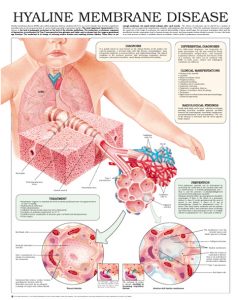Hyaline Membrane Disease
Hyaline membrane disease (HMD), also called respiratory distress syndrome (R.D.S.), is a severe disorder that results in significant mortality rates in the neonatal period. It can be found especially in premature babies. The most important characteristic of this disease is the lack of pulmonary surfactant at the level of the alveolar epithelium. The surfactant, a substance composed of lipoprotein, is synthesized by Type II pneumocytes from glycogen and lipids, and is released into the lungs as gestational age develops. The surfactant is in charge of reducing surface tension and enabling alveolar dilation. When there is not enough surfactant, the small alveoli collapse after each breath. The release of surfactant can be altered by a number of disorders, such as hypoxemia, hypothermia, acidosis, and pulmonary flow decrease. When the surfactant released is not enough, the small size of the lungs of newborns, the reduced distensibility of these small lungs, the increased respiratory effort and the insufficient alveolar oxygenation lead to hypoxia (oxygen decrease), and hypercapnia (carbon dioxide increase). In turn, this leads to an acid increase in blood, a condition known as acidosis, which results in pulmonary vasocontriction.
[hfe_template id=’14716′]
[hfe_template id=’16832′]

